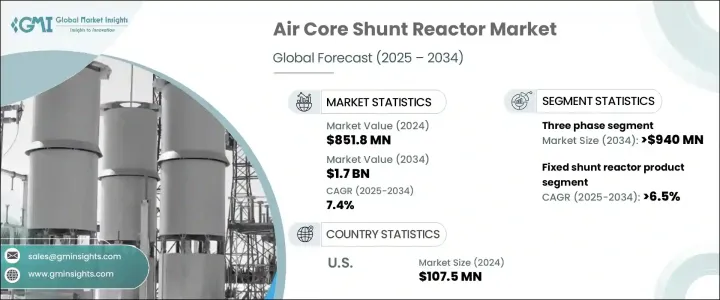
세계의 공심 분로 리액터 시장은 2024년 8억 5,180만 달러에 이르렀고, 2025년부터 2034년까지 연평균 복합 성장률(CAGR) 7.4%를 나타낼 것으로 예측됩니다.
이러한 리액터에 대한 수요 증가는 송전 인프라에 대한 대규모 투자와 현재 진행중인 송전망 근대화의 노력에 의해 추진되고 있습니다. 무효 전력 보상의 필요성은 계속 높아지고 있습니다.

세계의 급속한 도시화, 공업화, 전기의 진전은 전력 인프라의 대폭적인 개발을 촉진하고 있습니다. 공심 분로 리액터 시장 전망은 더욱 강력해지고 있습니다. 장거리 송전에 널리 사용되고 있는 고전압 직류(HVDC) 시스템도, 이 리액터의 도입 확대에 기여하고 있습니다.
| 시장 범위 | |
|---|---|
| 시작 연도 | 2024년 |
| 예측 연도 | 2025-2034년 |
| 시작 금액 | 8억 5,180만 달러 |
| 예측 금액 | 17억 달러 |
| CAGR | 7.4% |
시장은 주로 3상과 단상의 공심 분로 리액터의 2유형로 구분됩니다. 3상 공심 분로 리액터는 전압변동의 안정화와 송전손실의 저감에 중요한 역할을 하며, 재생가능에너지의 통합이나 HVDC 송전시스템에 필수적입니다.
공심 분로 리액터는 더욱 고정형과 가변형으로 분류되며, 고정형은 견조한 성장이 예상됩니다. 이 리액터는 무효 전력에 안정적인 보상을 제공하여 송전망의 효율과 신뢰성을 확보합니다.
2024년 미국의 공심 분로 리액터 시장 규모는 1억 750만 달러였으며, 향후 몇 년간은 꾸준한 성장이 전망될 예정입니다. 송전망의 회복력을 강화해, 송전 손실을 최소한으로 억제하는 것에 점점 초점이 맞추어지고, 공심 분로 리액터에 대한 투자는 증가의 일도를 추적하고 있습니다.
The Global Air Core Shunt Reactor Market reached USD 851.8 million in 2024 and is projected to grow at a CAGR of 7.4% from 2025 to 2034. The rising demand for these reactors is fueled by significant investments in power transmission infrastructure and ongoing grid modernization efforts. As power grids become more complex and renewable energy sources like wind and solar gain momentum, the need for reactive power compensation continues to grow. Air core shunt reactors play a crucial role in stabilizing voltage levels, minimizing power losses, and ensuring efficient energy transmission, making them indispensable in modern electricity networks.

Rapid urbanization, industrialization, and increased electrification worldwide are driving substantial developments in power infrastructure. Governments and private sector players are ramping up investments to enhance grid reliability and accommodate the surging demand for electricity. With renewable energy adoption accelerating, large-scale solar and wind power installations require robust transmission networks, further strengthening the market outlook for air core shunt reactors. High-voltage direct current (HVDC) systems, widely used for long-distance electricity transmission, are also contributing to the growing deployment of these reactors. The ability of air core shunt reactors to improve system stability and reduce losses makes them a preferred choice for utility providers globally.
| Market Scope | |
|---|---|
| Start Year | 2024 |
| Forecast Year | 2025-2034 |
| Start Value | $851.8 Million |
| Forecast Value | $1.7 Billion |
| CAGR | 7.4% |
The market is segmented into two primary types: three-phase and single-phase air core shunt reactors. Among these, the three-phase segment dominates the industry, holding the largest market share and showing strong growth potential. By 2034, this segment is expected to reach USD 940 million, driven by its widespread application in high-voltage transmission networks. Three-phase air core shunt reactors play a vital role in stabilizing voltage fluctuations and reducing transmission losses, making them essential for renewable energy integration and HVDC transmission systems. As energy transition efforts intensify worldwide, demand for three-phase reactors is expected to surge, especially in large-scale utility projects.
Air core shunt reactors are further classified into fixed and variable types, with the fixed segment expected to experience robust growth. Forecasts indicate a CAGR of 6.5% through 2034 for this segment, driven by the cost-effectiveness and reliability of fixed shunt reactors in high-voltage transmission applications. These reactors provide stable compensation for reactive power, ensuring grid efficiency and reliability. As energy grids expand and evolve, the role of fixed shunt reactors in maintaining system stability and preventing voltage instability becomes increasingly crucial.
The US air core shunt reactor market was valued at USD 107.5 million in 2024, with steady growth anticipated in the coming years. Market expansion is largely attributed to advancements in energy integration and modernization efforts within the national grid. The construction of high-capacity transmission lines to support renewable energy projects, including wind and solar farms, is driving demand for fixed and variable shunt reactors. With an increasing focus on enhancing grid resilience and minimizing transmission losses, investments in air core shunt reactors continue to rise. These reactors play a crucial role in managing electricity distribution during peak demand periods, positioning them as essential components in the evolving US power infrastructure landscape.